国际消防安全系统规则》的修正案.doc
- 格式:doc
- 大小:20.00 KB
- 文档页数:3
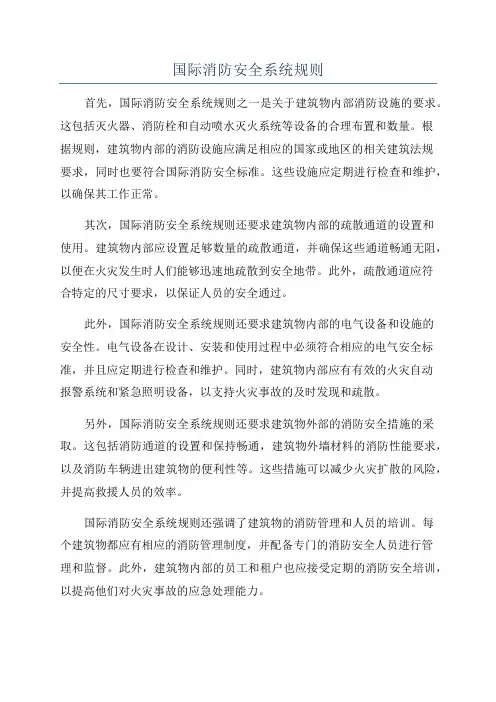
国际消防安全系统规则首先,国际消防安全系统规则之一是关于建筑物内部消防设施的要求。
这包括灭火器、消防栓和自动喷水灭火系统等设备的合理布置和数量。
根据规则,建筑物内部的消防设施应满足相应的国家或地区的相关建筑法规要求,同时也要符合国际消防安全标准。
这些设施应定期进行检查和维护,以确保其工作正常。
其次,国际消防安全系统规则还要求建筑物内部的疏散通道的设置和使用。
建筑物内部应设置足够数量的疏散通道,并确保这些通道畅通无阻,以便在火灾发生时人们能够迅速地疏散到安全地带。
此外,疏散通道应符合特定的尺寸要求,以保证人员的安全通过。
此外,国际消防安全系统规则还要求建筑物内部的电气设备和设施的安全性。
电气设备在设计、安装和使用过程中必须符合相应的电气安全标准,并且应定期进行检查和维护。
同时,建筑物内部应有有效的火灾自动报警系统和紧急照明设备,以支持火灾事故的及时发现和疏散。
另外,国际消防安全系统规则还要求建筑物外部的消防安全措施的采取。
这包括消防通道的设置和保持畅通,建筑物外墙材料的消防性能要求,以及消防车辆进出建筑物的便利性等。
这些措施可以减少火灾扩散的风险,并提高救援人员的效率。
国际消防安全系统规则还强调了建筑物的消防管理和人员的培训。
每个建筑物都应有相应的消防管理制度,并配备专门的消防安全人员进行管理和监督。
此外,建筑物内部的员工和租户也应接受定期的消防安全培训,以提高他们对火灾事故的应急处理能力。
总结起来,国际消防安全系统规则涉及了建筑物内外的消防设备、疏散通道、电气设备、消防安全措施以及消防管理和人员培训等方面。
遵守这些规则可以提高建筑物的消防安全性,并减少火灾事故对人员生命和财产的伤害。
在实施国际消防安全系统规则的基础上,各个国家和地区可以根据自身实际情况进一步完善和细化相关的法规和标准,以提高消防安全的水平。
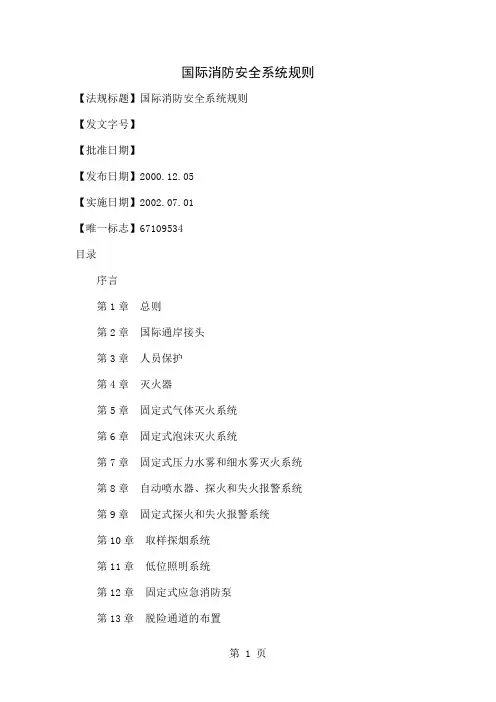
国际消防安全系统规则【法规标题】国际消防安全系统规则【发文字号】【批准日期】【发布日期】2000.12.05【实施日期】2002.07.01【唯一标志】67109534目录序言第1章总则第2章国际通岸接头第3章人员保护第4章灭火器第5章固定式气体灭火系统第6章固定式泡沫灭火系统第7章固定式压力水雾和细水雾灭火系统第8章自动喷水器、探火和失火报警系统第9章固定式探火和失火报警系统第10章取样探烟系统第11章低位照明系统第12章固定式应急消防泵第13章脱险通道的布置第14章固定式甲板泡沫系统第15章惰性气体系统国际消防安全系统规则(消防安全系统规则)前言1 本规则的目的是为经修正的《1974年国际海上人命安全公约》第II-2章所要求的消防安全系统提供具体工程规范的国际标准。
2 在2002年7月1日或以后,本规则对于经修正的《1974年国际海上人命安全公约》所要求的消防安全系统将具有强制性。
本规则今后的任何修正案都必须按该公约第VIII条规定的程序予以通过并生效。
第1章总则1 适用范围1.1 本规则适用于经修正的《1974年安全公约》第II-2章所述消防安全系统。
1.2 除非另有明文规定,本规则适用于2002年7月1日或以后安放龙骨或处于类似建造阶段的船舶的消防安全系统。
2 定义2.1 主管机关系指船舶的船旗国政府。
2.2 公约系指经修正的《1974年国际海上人命安全公约》,2.3 消防安全系统规则系指经修正的《1974年海上人命安全公约》第II-2章中定义的《国际消防安全系统规则》。
2.4 就本规则而言,公约第II章规定的定义同样适用。
3 等效和现代技术的应用为了给消防安全系统的现代技术和开发留有余地,如果能满足公约第II-2章F部分的要求,主管机关可以认可本规则中未予规定的消防安全系统。
4 毒性灭火剂的使用如果主管机关认为,无论是本身还是在某种可能条件下,某灭火剂的使用会释放有毒气体、液体和其它物质,其数量会对人体造成危害,应禁止使用。
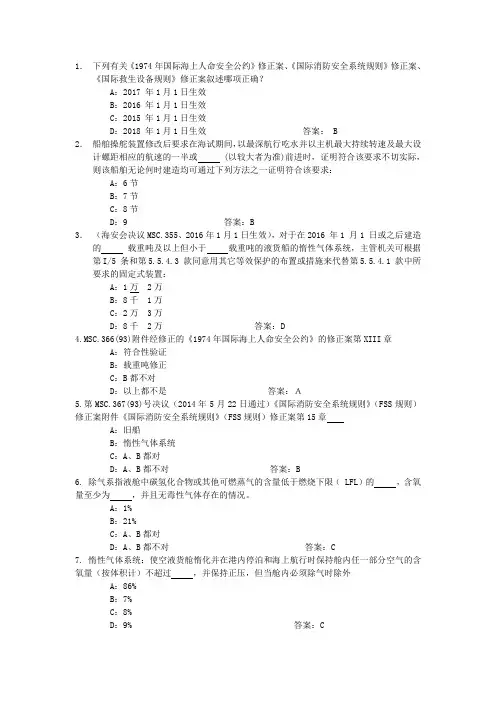
1.下列有关《1974年国际海上人命安全公约》修正案、《国际消防安全系统规则》修正案、《国际救生设备规则》修正案叙述哪项正确?A:2017 年1月1日生效B:2016 年1月1日生效C:2015 年1月1日生效D:2018 年1月1日生效答案: B2.船舶操舵装置修改后要求在海试期间,以最深航行吃水并以主机最大持续转速及最大设计螺距相应的航速的一半或 (以较大者为准)前进时,证明符合该要求不切实际,则该船舶无论何时建造均可通过下列方法之一证明符合该要求:A:6节B:7节C:8节D:9 答案:B3.(海安会决议MSC.355、2016年1月1日生效),对于在2016 年1 月1 日或之后建造的载重吨及以上但小于载重吨的液货船的惰性气体系统,主管机关可根据第I/5 条和第5.5.4.3 款同意用其它等效保护的布置或措施来代替第5.5.4.1 款中所要求的固定式装置:A:1万 2万B:8千 1万C:2万 3万D:8千 2万答案:D4.MSC.366(93)附件经修正的《1974年国际海上人命安全公约》的修正案第XIII章A:符合性验证B:载重吨修正C:B都不对D:以上都不是答案:A5.第MSC.367(93)号决议(2014年5月22日通过)《国际消防安全系统规则》(FSS规则)修正案附件《国际消防安全系统规则》(FSS规则)修正案第15章A:旧船B:惰性气体系统C:A、B都对D:A、B都不对答案:B6. 除气系指液舱中碳氢化合物或其他可燃蒸气的含量低于燃烧下限( LFL)的,含氧量至少为,并且无毒性气体存在的情况。
A:1%B:21%C:A、B都对D:A、B都不对答案:C7. 惰性气体系统:使空液货舱惰化并在港内停泊和海上航行时保持舱内任一部分空气的含氧量(按体积计)不超过,并保持正压,但当舱内必须除气时除外A:86%B:7%C:8%D:9% 答案:C8.惰性气体的来源可以是:1 来自主锅炉或辅锅炉的经处理的烟道气体;2 来自燃油或燃气的气体发生器的气体;3 来自氮气发生器的气体。
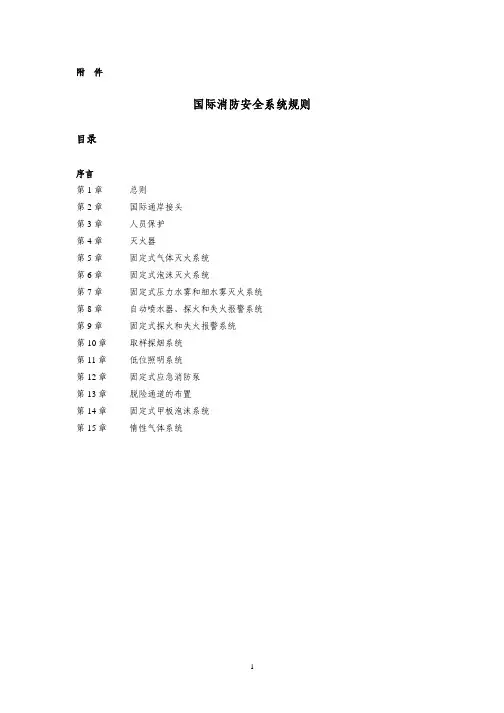
附 件国际消防安全系统规则目录序言第1章总则第2章国际通岸接头第3章人员保护第4章灭火器第5章固定式气体灭火系统第6章固定式泡沫灭火系统第7章固定式压力水雾和细水雾灭火系统第8章自动喷水器、探火和失火报警系统第9章固定式探火和失火报警系统第10章取样探烟系统第11章低位照明系统第12章固定式应急消防泵第13章脱险通道的布置第14章固定式甲板泡沫系统第15章惰性气体系统国际消防安全系统规则(消防安全系统规则)前言1 本规则的目的是为经修正的《1974年国际海上人命安全公约》第II-2章所要求的消防安全系统提供具体工程规范的国际标准。
2 在2002年7月1日或以后,本规则对于经修正的《1974年国际海上人命安全公约》所要求的消防安全系统将具有强制性。
本规则今后的任何修正案都必须按该公约第VIII条规定的程序予以通过并生效。
第1章—总则1 适用范围1.1 本规则适用于经修正的《1974年安全公约》第II-2章所述消防安全系统。
1.2 除非另有明文规定,本规则适用于2002年7月1日或以后安放龙骨或处于类似建造阶段的船舶的消防安全系统。
2 定义2.1 主管机关系指船舶的船旗国政府。
2.2 公约系指经修正的《1974年国际海上人命安全公约》,2.3 消防安全系统规则系指经修正的《1974年海上人命安全公约》第II-2章中定义的《国际消防安全系统规则》。
2.4 就本规则而言,公约第II章规定的定义同样适用。
3 等效和现代技术的应用为了给消防安全系统的现代技术和开发留有余地,如果能满足公约第II-2章F部分的要求,主管机关可以认可本规则中未予规定的消防安全系统。
4 毒性灭火剂的使用如果主管机关认为,无论是本身还是在某种可能条件下,某灭火剂的使用会释放有毒气体、液体和其它物质,其数量会对人体造成危害,应禁止使用。
第2章—国际通岸接头1 适用范围本章具体规定了公约第II-2章所要求的国际通岸接头的规范。
2 工程规范2.1 标准尺寸国际通岸接头法兰的标准尺寸应符合下表要求:表2.1—国际通岸接头标准尺寸名 称尺 寸外径178 mm内径64 mm螺栓圈直径132 mm法兰槽口直径为19 mm的孔4个,等距离分布在上述直径的螺栓圈上,开槽口至法兰盘的外缘法兰厚度至少为14.5 mm螺栓和螺母4副、每副的直径为16 mm,长度为50 mm2.2 材料和配件国际通岸接头应用钢材或其它等效材料制成并设计成能承受1.0 N/mm2的工作压力。
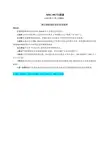
MSC.98(73)决议(2000年12月5日通过)通过国际消防安全系统规则海安会,忆及国际海事组织公约第28(b)条关于本委员会的职责,注意到1974年国际海上人命安全公约第Ⅱ-2章的修订(以下简称“本公约”),认识到有必要继续强制应用,经修订的本公约第Ⅱ-2章所要求的消防安全系统,注意到本委员会以MSC.99(73)决议特别通过了经修订的本公约第Ⅱ-2章,其使国际消防安全系统规则(FSS)按照本公约的规定成为强制性要求,业已审议了在其73次会议上建议的FSS规则的文本,1.通过了国际消防安全系统规则(FSS规则),其文本载于本决议的附件中;2.敦请本公约各缔约国政府注意:在经修订的本公约第Ⅱ-2章生效后,FSS规则将于2002年7月1日生效;3.要求秘书长将本决议案核证无误的副本及其在附件中所载的FSS规则的文本分发给各缔约国政府;4.进一步要求秘书长将本决议案的副本及附件分发给非本公约缔约国的本组织成员国政府。
含MSC.206(81),MSC.217(82),MSC.292(87),MSC.311(88)附件国际消防安全系统规则目录前言第1章 通则第2章 国际通岸接头第3章 人员保护第4章 灭火器第5章 固定式气体灭火系统第6章 固定式泡沫灭火系统第7章 固定式压力水雾和细水雾灭火系统第8章 自动喷水器,探火和失火报警系统第9章 固定式探火和失火报警系统第10章抽烟式探火系统第11章低位照明系统第12章固定式应急消防泵第13章脱险通道布置第14章固定式甲板泡沫系统第15章惰性气体系统第16章固定式碳氢化合物气体探测系统(MSC.292(87),2012年1月1日生效)国际消防安全系统规则(消防安全系统规则)前言1本规则旨在为经修正的1974国际海上人命安公约第Ⅱ-2章所要求的消防安全系统提供特定工程技术规定的国际标准。
22002年7月1日或以后,根据经修正的1974年国际海上人命安全公约要求的本消防安全系统规则将作为强制性要求。

附 件国际消防安全系统规则目录序言第1章总则第2章国际通岸接头第3章人员保护第4章灭火器第5章固定式气体灭火系统第6章固定式泡沫灭火系统第7章固定式压力水雾和细水雾灭火系统第8章自动喷水器、探火和失火报警系统第9章固定式探火和失火报警系统第10章取样探烟系统第11章低位照明系统第12章固定式应急消防泵第13章脱险通道的布置第14章固定式甲板泡沫系统第15章惰性气体系统国际消防安全系统规则(消防安全系统规则)前言1 本规则的目的是为经修正的《1974年国际海上人命安全公约》第II-2章所要求的消防安全系统提供具体工程规范的国际标准。
2 在2002年7月1日或以后,本规则对于经修正的《1974年国际海上人命安全公约》所要求的消防安全系统将具有强制性。
本规则今后的任何修正案都必须按该公约第VIII条规定的程序予以通过并生效。
第1章—总则1 适用范围1.1 本规则适用于经修正的《1974年安全公约》第II-2章所述消防安全系统。
1.2 除非另有明文规定,本规则适用于2002年7月1日或以后安放龙骨或处于类似建造阶段的船舶的消防安全系统。
2 定义2.1 主管机关系指船舶的船旗国政府。
2.2 公约系指经修正的《1974年国际海上人命安全公约》,2.3 消防安全系统规则系指经修正的《1974年海上人命安全公约》第II-2章中定义的《国际消防安全系统规则》。
2.4 就本规则而言,公约第II章规定的定义同样适用。
3 等效和现代技术的应用为了给消防安全系统的现代技术和开发留有余地,如果能满足公约第II-2章F部分的要求,主管机关可以认可本规则中未予规定的消防安全系统。
4 毒性灭火剂的使用如果主管机关认为,无论是本身还是在某种可能条件下,某灭火剂的使用会释放有毒气体、液体和其它物质,其数量会对人体造成危害,应禁止使用。
第2章—国际通岸接头1 适用范围本章具体规定了公约第II-2章所要求的国际通岸接头的规范。
2 工程规范2.1 标准尺寸国际通岸接头法兰的标准尺寸应符合下表要求:表2.1—国际通岸接头标准尺寸名 称尺 寸外径178 mm内径64 mm螺栓圈直径132 mm法兰槽口直径为19 mm的孔4个,等距离分布在上述直径的螺栓圈上,开槽口至法兰盘的外缘法兰厚度至少为14.5 mm螺栓和螺母4副、每副的直径为16 mm,长度为50 mm2.2 材料和配件国际通岸接头应用钢材或其它等效材料制成并设计成能承受1.0 N/mm2的工作压力。
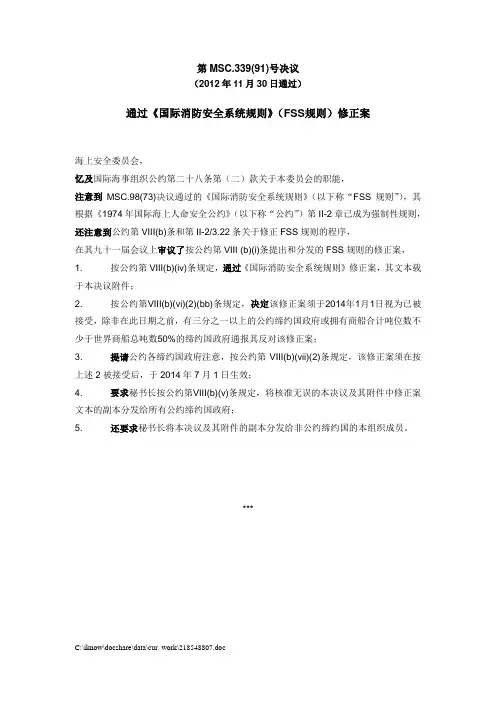
第MSC.339(91)号决议(2012年11月30日通过)通过《国际消防安全系统规则》(FSS规则)修正案海上安全委员会,忆及国际海事组织公约第二十八条第(二)款关于本委员会的职能,注意到MSC.98(73)决议通过的《国际消防安全系统规则》(以下称“FSS规则”),其根据《1974年国际海上人命安全公约》(以下称“公约”)第II-2章已成为强制性规则,还注意到公约第VIII(b)条和第II-2/3.22条关于修正FSS规则的程序,在其九十一届会议上审议了按公约第VIII (b)(i)条提出和分发的FSS规则的修正案,1. 按公约第VIII(b)(iv)条规定,通过《国际消防安全系统规则》修正案,其文本载于本决议附件;2. 按公约第VIII(b)(vi)(2)(bb)条规定,决定该修正案须于2014年1月1日视为已被接受,除非在此日期之前,有三分之一以上的公约缔约国政府或拥有商船合计吨位数不少于世界商船总吨数50%的缔约国政府通报其反对该修正案;3. 提请公约各缔约国政府注意,按公约第VIII(b)(vii)(2)条规定,该修正案须在按上述2被接受后,于2014年7月1日生效;4. 要求秘书长按公约第VIII(b)(v)条规定,将核准无误的本决议及其附件中修正案文本的副本分发给所有公约缔约国政府;5. 还要求秘书长将本决议及其附件的副本分发给非公约缔约国的本组织成员。
***附件《国际消防安全系统规则》(FSS规则)修正案第3章人员保护1 现有2.1.2由下列二个新段落替代:“2.1.2.1 呼吸器应为1具自给式压缩空气呼吸器,其瓶内储气量应至少为1,200 l,或1具其他型式的自给式呼吸器,其可供使用的时间至少为30 min。
呼吸器所有的空气瓶应能互换。
2.1.2.2 压缩空气呼吸器应设有听觉报警和视觉或其他装置,以在瓶内储气量降至不少于200 l前向使用者发出警报。
”第5章固定式气体灭火系统2 在2.1.1.1的第二句后,新增句子如下:“未采用至少A-0级分隔分开并设有独立通风系统的相邻处所应视为同一处所。
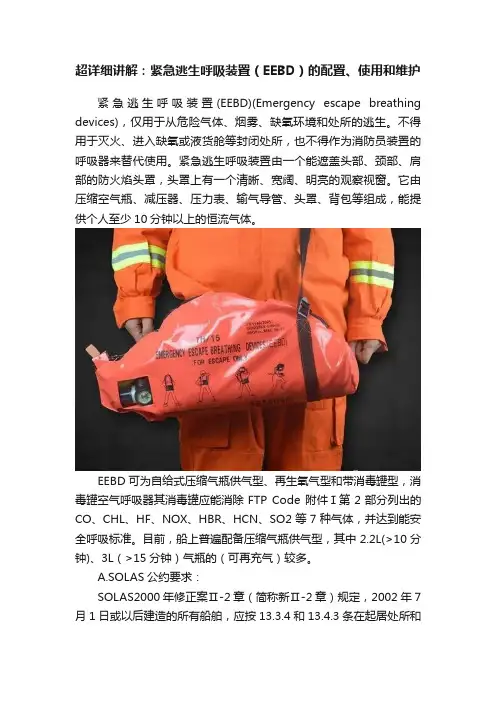
超详细讲解:紧急逃生呼吸装置(EEBD)的配置、使用和维护紧急逃生呼吸装置(EEBD)(Emergency escape breathing devices),仅用于从危险气体、烟雾、缺氧环境和处所的逃生。
不得用于灭火、进入缺氧或液货舱等封闭处所,也不得作为消防员装置的呼吸器来替代使用。
紧急逃生呼吸装置由一个能遮盖头部、颈部、肩部的防火焰头罩,头罩上有一个清晰、宽阔、明亮的观察视窗。
它由压缩空气瓶、减压器、压力表、输气导管、头罩、背包等组成,能提供个人至少10分钟以上的恒流气体。
EEBD可为自给式压缩气瓶供气型、再生氧气型和带消毒罐型,消毒罐空气呼吸器其消毒罐应能消除FTP Code 附件Ⅰ第2部分列出的CO、CHL、HF、NOX、HBR、HCN、SO2等7种气体,并达到能安全呼吸标准。
目前,船上普遍配备压缩气瓶供气型,其中2.2L(>10分钟)、3L(>15分钟)气瓶的(可再充气)较多。
A.SOLAS公约要求:SOLAS2000年修正案Ⅱ-2章(简称新Ⅱ-2章)规定,2002年7月1日或以后建造的所有船舶,应按13.3.4和13.4.3条在起居处所和机器处所配置紧急逃生呼吸器(EEBD),且应符合消防安全系统规则(FSS Code)相关要求(第3章2.2条)。
新Ⅱ-2章1.2.2.2条规则规定2002年7月1日以前建造的所有船舶,应在2002年7月1日以后进行的第一次检验时,按规定数量配齐EEBD。
具体要求:1 总则General1.1紧急脱险呼吸装置是仅在逃离有毒气体舱室时使用的空气或氧气供应装置.应为认可型。
An EEBD is a supplied air or oxygen device only used for escape from a compartment that has a hazardous atmosphere and shall be of an approved type.1.2 紧急脱险呼吸装置不应用于灭火、进入缺氧隔离空舱或舱室、或由消防员配带。
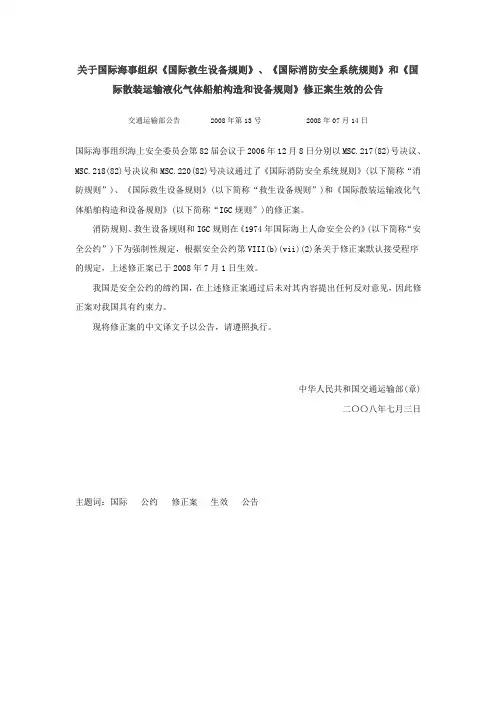
关于国际海事组织《国际救生设备规则》、《国际消防安全系统规则》和《国际散装运输液化气体船舶构造和设备规则》修正案生效的公告交通运输部公告2008年第13号2008年07月14日国际海事组织海上安全委员会第82届会议于2006年12月8日分别以MSC.217(82)号决议、MSC.218(82)号决议和MSC.220(82)号决议通过了《国际消防安全系统规则》(以下简称“消防规则”)、《国际救生设备规则》(以下简称“救生设备规则”)和《国际散装运输液化气体船舶构造和设备规则》(以下简称“IGC规则”)的修正案。
消防规则、救生设备规则和IGC规则在《1974年国际海上人命安全公约》(以下简称“安全公约”)下为强制性规定,根据安全公约第VIII(b)(vii)(2)条关于修正案默认接受程序的规定,上述修正案已于2008年7月1日生效。
我国是安全公约的缔约国,在上述修正案通过后未对其内容提出任何反对意见,因此修正案对我国具有约束力。
现将修正案的中文译文予以公告,请遵照执行。
中华人民共和国交通运输部(章)二〇〇八年七月三日主题词:国际公约修正案生效公告附件《国际救生设备规则》的修正案第I 章总则1.1 定义1 删除第1.1.8款,将现有第1.1.9、1.1.10和1.1.11款分别重新编为第1.1.8、1.1.9和1.1.10款。
1.2 救生设备的一般要求2. 在第1.2.3款末尾新增以下一句:“对烟火救生设备,生产厂应在产品上牢固地标记失效日期。
”2.2 救生衣3 在第2.2.1.16款中,“浮力”和“装置”间插入“线或其它”。
2.3 救生服4 现有第2.3.1.1.1款替换如下:“.1 能不经帮助在2 分钟内打开并穿上,包括穿上任何有关服装的时间,如果需要将救生衣与救生服连同穿着,则还包括穿上1件救生衣的时间,以及人工充气室(如安装)的充气;”5 在第2.3.1.5款中,“浮力”和“装置”间插入“线或其它”。
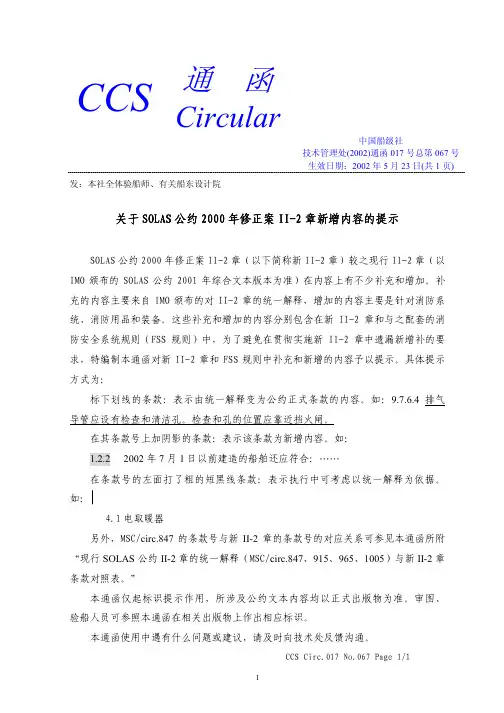
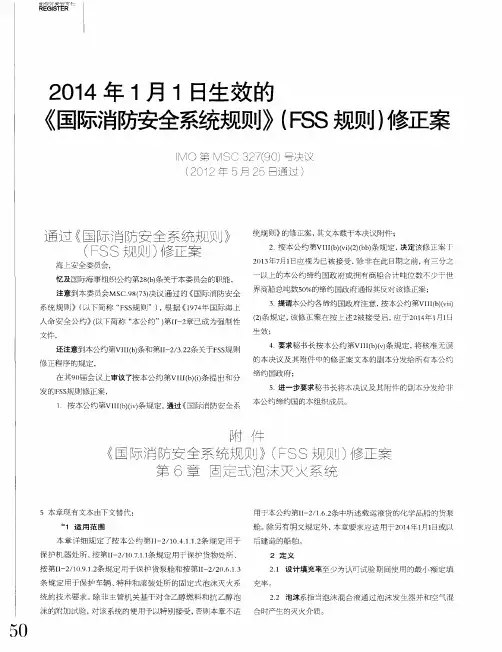
第MSC.311(88)号决议(2010年12月3日通过)《国际消防安全系统规则(消防规则)》修正案海上安全委员会忆及《国际海事组织公约》第28(b)条关于本委员会的职能。
注意到本委员会以第MSC.98(73)号决议通过的《国际消防安全系统规则》(以下简称“消防规则”),根据《1974年国际海上人命安全公约》(以下简称“该公约”)第II-2章已成为强制性文件。
还注意到该公约第VIII(b)条和第II-2/3.22条关于消防规则修正程序的规定。
在其第88届会议上审议了按该公约第VIII(b)(i)条提出和分发的消防规则修正案,1.按该公约第VIII(b)(iv)条规定,通过《国际消防安全系统规则》的修正案,其文本载于本决议附件中;2.按该公约第VIII(b)(vi)(2)(bb)条规定,决定该修正案应于2012年1月1日视为已被接受,除非在此日期之前,有三分之一以上的该公约缔约国政府或拥有商船合计总吨位不少于世界商船总吨位50%的缔约国政府通报其反对该修正案;3.提请《安全公约》各缔约国政府注意,按照该公约第VIII(b)(vii)(2)条规定,该修正案在按上述第2段被接受后,应于2012年7月1日生效;4. 要求秘书长按照该公约第VIII(b)(v)条规定,将本决议及其附件中的修正案文本的核证无误副本分送发该公约所有缔约国政府;5. 进一步要求秘书长将本决议及其附件的副本送发非该公约缔约国的本组织会员国。
附件《国际消防安全系统规则(消防规则)》修正案现有第9章由以下替代:第9章固定式探火和失火报警系统1 适用范围1.1 本章详细规定了公约第II-2章所要求的固定式探火和失火报警系统的技术要求。
除另有明文规定外,本章要求应适用于2012年7月1日或以后建造的船舶。
1.2 定义1.2.1 分区系指指示装置标示的一组火警探测器和手动报警按钮。
1.2.2 分区识别能力系指系统具有识别已触发的探测器或手动报警按钮所在分区的能力。
《国际消防安全系统规则》国际海事组织(IMO)于2000年12月5日以MSC.98(73)号决议通过了《国际消防安全系统规则》(以下简称FSS规则)。
与此同时,IMO还以MSC.99(73)号决议通过了对经修正的《1974年国际海上人命安全公约》(以下简称安全公约)第II一2章的修正案。
在通过此项修正案时,IMO海上安全委员会决定,FSS规则必须在上述修正案生效后于2002年7月1日生效。
按照安全公约规定的默认接受程序,该修正案已于2002年7月1日生效,因此,FSS规则也于同日生效。
根据安全公约上述修正案的规定,FSS规则为强制性规则。
我国是安全公约的缔约国,在该修正案通过之后没有对其内容提出任何反对意见,因此,该规则对我国具有约束力。
中华人民共和国交通部(章)二00二年七月二十六日国际消防安全系统规则1本规则的目的是为经修正的《1974年国际海上人命安全公约》第II-2章所要求的消防安全系统提供具体工程规范的国际标准。
2在2002年7月1日或以后,本规则对于经修正的《1974年国际海上人命安全公约》所要求的消防安全系统将具有强制性。
本规则今后的任何修正案都必须按该公约第VIII条规定的程序予以通过并生效。
第1章总则1适用范围1.1本规则适用于经修正的《1974年安全公约》第II-2章所述消防安全系统。
1.2除非另有明文规定,本规则适用于2002年7月1日或以后安放龙骨或处于类似建造阶段的船舶的消防安全系统。
2定义2.1主管机关系指船舶的船旗国政府。
2.2公约系指经修正的《1974年国际海上人命安全公约》,2.3消防安全系统规则系指经修正的《1974年海上人命安全公约》第II-2章中定义的《国际消防安全系统规则》。
2.4就本规则而言,公约第II章规定的定义同样适用。
3等效和现代技术的应用为了给消防安全系统的现代技术和开发留有余地,如果能满足公约第II-2章F部分的要求,主管机关可以认可本规则中未予规定的消防安全系统。
国际消防安全系统规则(fss规则)的修正案(Amendments to the international fire safety system rules (FSS rules))Amendments to the international fire safety system rules (FSS rules)The fifth chapter fixed gas fire extinguishing systemThe text of the fifth chapters is replaced by the following text:"1 scope of application"This chapter specifies the specifications for fixed gas fire extinguishing systems specified in chapter II - 2 of the convention.2 engineering specifications2.1 general provisions2.1.1 fire extinguishing agent2.1.1.1 if the quantity of fire extinguishing agent is required to protect more than one place, the quantity of fire extinguishing agent used shall not exceed the maximum quantity required for any place protected. The system shall be equipped with a normally closed control valve, and its arrangement can deliver the fire extinguishing agent to the appropriate place.The number of 2.1.1.2 in the calculation of the required fireextinguishing agent, was converted to a starting air receiver free air volume the amount of the total amount should be included in the machinery space. Alternatively, a drain pipe can be connected from the safety valve to the open air.2.1.1.3 shall equip seafarers with the equipment for safety inspection of the quantity of extinguishing agents in the fire fighting container.2.1.1.4 containers, piping and related compression components for storage of fire extinguishing agents shall be considered in terms of their locations and the maximum environmental temperatures that may be encountered during use, and shall be designed in accordance with the applicable pressure rules agreed upon by the competent authorities. (2.1.2 installation requirementsThe layout of the 2.1.2.1 fire extinguishing manifold and the position of the nozzle should be able to distribute the fire extinguishing agent evenly. The system flow should be calculated using the computational technique approved by the competent authority.2.1.2.2 unless otherwise approved by the competent authority, the pressure vessel for storage of fire extinguishing agents other than steam shall be placed outside the protected premises in accordance with article II-2/10.4.3 of the convention.The spare parts of the 2.1.2.3 system should be stored on the ship and satisfied with the competent authorities.2.1.2.4 shall be equipped with a pressure release valve for access to the valve layout, and the outer end of the valve shall lead to the open deck.The melting point temperature of the structural material of all the discharge pipes, equipment and nozzles in the protected area of 2.1.2.5 shall exceed 925 degrees centigrade. Adequate support shall be provided for piping and related equipment.2.1.2.6 shall install an air test equipment capable of carrying out the requirements of paragraph 2.2.3.1 in the discharge pipe.2.1.3 system control requirements2.1.3.1 shall be equipped with a control valve for the pipeline to be sent to the protected area, and the control valve shall clearly indicate the place where the pipeline leads. Proper arrangements should be made to prevent the release of the fire extinguisher into the premises due to negligence. If the cargo premises equipped with gas fire extinguishing system are used as passenger premises, the connection of gas shall be cut off during use. The pipeline can pass through the residential area, but the pipeline should have a considerable thickness, and the air tightness should be tested after installation. The test pressure head is not less than 5N/mm2. In addition, the pipeline passing through the residential place is only welded, and no drainage openings or other openings are allowed in such places. The piping shall not pass through the refrigerated premises.2.1.3.2 should be equipped with an automatic audio visual alarm device which can automatically alarm when any fire extinguisher is released at any place where the roll is located or where the personnel are usually working or entering or leaving the premises. Sound alarm device should be located in all work condition in the protected premises can be heard, and the alarm device and other sound alarm device to distinguish the sound by adjusting the pressure or sound format. Before release, the alarm should be automatically started (for example, by opening the door of the release box). The alarm time should be determined according to the time required to evacuate the premises, but no less than 20 seconds prior to the release of the extinguishing agent. There is no need to install such an alarm in the traditional cargo premises and small areas (such as compressor room, paint room, etc.) with local release control.The control device of 2.1.3.3 fixed gas fire extinguishing system should be easy to take out and operate simply, and should be placed in groups as few as possible without being cut off by the fire in the protected place. In order to ensure the safety of the personnel, a clear explanation of the operation of the system should be provided at every location.2.1.3.4 automatic fire extinguishing device shall not be used unless permitted by the competent authorities.2.2 carbon dioxide systemNumber of 2.2.1 fire extinguishing agents2.2.1.1 unless otherwise specified,The amount of carbon dioxide available at the cargo premises shall be sufficient to release the free gas of volume equal to at least 30% of the total volume of the maximum cargo space to be protected.The amount of carbon dioxide carried by the 2.2.1.2 machine site should be sufficient to emit at least equal amounts of free gas in the greater part of the following two:The total volume of the largest machinery spaces.1 protected 40%, the volume does not include the upper part of the casing, from a level cabin shed surface when the horizontal surface area is equal to or less than 40% cabin shed area of a horizontal cross section at the midpoint of the lowest part of the cabin to shed from the top of the cabin; or.2 35% of the total volume of the largest protected machine premises, including the cabin.For 2000 of the total 2.2.1.3 tons of cargo, if there are two or more than two machine spaces which are not completely separated, is regarded as a place, two percentage of the article referred to in paragraph 2.2.1.2 can be reduced to 35% and 30% respectively.2.2.1.4 for the purpose of this section, the volume of free CO2 should be calculated by 0.56m3/kg.The fixed piping system of the 2.2.1.5 machine site shall allow85% of the gas to be injected into the premises within 2 minutes.2.2.2 control deviceCarbon dioxide system should meet the following requirements:.1 shall set up two independent control devices to release carbon dioxide to the protected site and ensure the start of the alarm device. A control unit is used to open the valves that transfer the gas to the pipeline in the protected place, and another set of control devices is used to remove the gas from the storage container. Positive measures should be taken to ensure that it can be operated in accordance with this order; and.2 two sets of control devices should be located in a release box indicating the specific control of the premises. If the box of the control device is locked, a key should be placed in the box near the control box with a broken glass cover.Installation test of 2.2.3After installation, pressure test and test of the system, the following must be done:.1 test of free air flow in all pipes and nozzles; and Functional test of.2 alarm equipment.2.2.4 low pressure CO2 systemIf a low pressure CO2 system is installed in accordance with this regulation, the following requirements shall be applied:2.2.4.1 system control device and refrigeration equipment should be located in the storage pressure bottle.2.2.4.2 liquid carbon dioxide rating should be stored in the bottle at the working pressure of 1.8 to 2.2N/mm2. The usual hydraulic pressure in the container shall be limited to providing sufficient steam space to allow the expansion of the liquid under the maximum storage temperature set by the pressure relief valve, but not exceeding 95% of the vessel volume.2.2.4.3 shall be provided with a device for use in:.1 pressure measurement;.2 high voltage alarm without setting the release valve;.3 low voltage alarm when not less than 1.8N/mm2;.4 branch line with check valve filled with cylinder;.5 emission pipe;.6 displays the number of liquefied carbon dioxide on the cylinder;.7 two safety valves.2.2..4.4 two safety relief valves should be arranged so that one of the valves is connected to the bottle and the other can be closed. Release valve set shall not be less than 1.1 times the working pressure. Each valve shall be able to release the gases produced under the condition of a pressure rise of no more than 20% of the set pressure. It should be discharged directly from safety valve to the outside.2.2.4.5 tube and permanent with carbon dioxide through the pipeline should be insulated device to prevent the device to cut off power, equivalent to the refrigerating device starting pressure under the condition of the safety valve in 24 hours at 45 C ambient temperature and initial pressure.The 2.2.4.6 cylinder shall be equipped with two sets of fully independent automatic refrigerated devices, each of which is equipped with a compressor and associated main motors, a steam engine and a condenser.2.2.4.7 the refrigerating capacity of each refrigerating device and the automatic controller shall ensure the temperature required to work at sea at temperatures up to 32 degrees Celsius and ambient temperatures up to 45 C for 24 hours.2.2.4.8 each electrical refrigeration device shall be supplied by the main power supply line through a separate feeder line.2.2.4.9 if necessary, the cooling water supplied by the refrigeratorshall be supplied by at least two circulating pumps, one of which is used as a backup pump. The standby pump can be used as a pump for other purposes, but the use of the standby pump as a cooling shall not interfere with any other basic functions of the ship. Cooling water shall be taken from at least two seawater interfaces, preferably at port side and starboard side.2.2.4.10 should be isolated in the valve valve at each part of pipeline and pressure accumulation may be more than any of the components of the design pressure, the installation of safety relief device.2.2.4.11 under the following conditions, the central control station should give sound and image alarm:.1 according to paragraph 2.2.4.2, when the pressure in the cylinder reaches the low limit and the high limit value;.2 any refrigeration device cannot work;.3 reaches the lowest allowable liquid level in the barrel.2.4.4.12 if the system is to work at more than one place, a carbon dioxide emission control device should be set, such as an automatic timer or an accurate number identifier at the control position.2.4.4.13 if it is equipped with automatic control of the amount of CO2 discharged into the protected premises, it should also be manually controlled.Requirements for 2.3 steam systemOne or several boilers supplying steam should be able to supply at least 1kg of steam per 0.75m3 at the total volume of one of the largest protected sites per hour. In addition to meeting the above requirements, the system shall be determined by the competent authority and satisfied with the competent authorities in all respects.2.4 systems for gaseous products after combustion of fuelGeneral rules of 2.4.1The system shall comply with the requirements of the 2.4.2 clause, such as the production of gases other than carbon dioxide or the steam permitted in the 2.3 section of the vessel and used as a fire extinguishing agent.Requirements of 2.4.2 system2.4.2.1 gaseous productsGas should be the gaseous product after combustion, and its oxygen content, carbon monoxide content, corrosion component and any solid combustible component should be reduced to the minimum allowable amount.Capability of 2.4.2.2 fire extinguishing system2.4.2.2.1, if used in a fixed fire extinguishing system as afire extinguisher to protect the premises of a machine, should provide equivalent protection to a fixed system using carbon dioxide as a fire extinguishing agent.2.4.2.2.2 as in the fixed fire extinguishing system used in the protection of the goods as gas premises fire extinguishing agent, the gas should be enough, so every hour can supply the free gas volume at least equal to the maximum of a protected place for 25% of the total volume, and can continue to supply 72 hours.Equivalent fixed gas fire extinguishing system for 2.5 machine space and cargo pump compartmentThe fixed gas fire extinguishing system, which is equivalent to the provisions in paragraphs 2.2 to 2.4, shall be approved by the competent authority in accordance with the guidelines formulated by the organization. ("* * *(ISO publication - 9809/1: seamless seamless steel inflator (design, construction and testing);ISO-3500: seamless steel carbon dioxide cylinder. As for the fixed on the ship fire extinguishing device, the main external dimensions, specify the ship fixed fire extinguishing device using the seamless steel tube, carbon dioxide, filling rate and identification, in order to speed up the exchange ability;ISO-5923: fire extinguishing agent carbon dioxide;ISO-13769: Pump - Stamp MarkingISO-6406: periodic inspection and test of seamless steel inflator;ISO-9329, part first: seamless steel tubes for pressure - Technical delivery conditions - part first: unalloyed steels with specified room temperature performance;ISO-9329: part second: seamless steel tubes for pressure - Technical delivery conditions - Part second: unalloyed steels and alloy steels with specific heating up properties;ISO-9330, part first: welded steel tubes for pressure - Technical delivery conditions - part first: unalloyed steels with specified room temperature properties;ISO-9330, part first: welded steel tubes for pressure - Technical delivery conditions - Part second: non alloy steel resistance and conductance welding with non alloyed steel tubes and alloy steel tubes with specific heating up performance;See "amendment guidelines for fixed gas fire extinguishing systems referred to in the safety convention" for the approval of machine premises and cargo pump tanks (MSC/Circ.)Circular No. 848 and the guidelines for fixed smoke extinguishing systems referred to as "fixed gas fire extinguishing systems referred to in the security Convention" (letter MSC/Circ.1007).***[JimiSoft: Unregistered Software ONLY Convert Part Of File! Read Help To Know How To Register.]***。
国际消防安全系统规则(FSS规则)的修正案第5章-固定式气体灭火系统现有第5章案文由下述案文代替:“1 适用范围本章具体规定了公约第II-2章要求的固定式气体灭火系统的规范。
2 工程规范2.1 总则2.1.1 灭火剂2.1.1.1 若要求灭火剂的数量能保护一个以上处所,则供使用的灭火剂数量不必超过所保护的任何一个处所所需要的最大数量。
该系统应配备通常为密闭式控制阀,且其布置可以将灭火剂输送至相应的处所。
2.1.1.2 在计算所需灭火剂的数量时,被转换为自由空气量的启动空气接收器的量应算入机器处所的总量中去。
或者,可以从安全阀接一根排放管,直接引向露天。
2.1.1.3 应为船员配备安全检查灭火容器中灭火剂数量的设备。
2.1.1.4 贮存灭火剂的容器、管路及其相关的受压部件,应考虑到其位置和使用中可能遇到过的最大环境温度按照主管机关同意的实用压力规则来设计。
*2.1.2 安装要求*ISO出版物-9809/1:可填充式无缝钢气筒(设计、构造和试验);ISO-3500:无缝钢二氧化碳筒。
对于船上的固定式灭火装置,具体说明船上固定式灭火装置使用的无缝钢二氧化碳筒的主要外部尺寸、附属件、填充速率和标识,以便加快相互交换能力;ISO-5923:防火-灭火剂-二氧化碳;ISO-13769:气筒-戳记标识ISO-6406:无缝钢气筒的定期检查和试验;ISO-9329,第1部分:压力用无缝钢管-技术交付条件-第1部分:具有特定室温性能的非合金钢;ISO-9329:第2部分:压力用无缝钢管-技术交付条件-第2部分:具有特定升温性能的非合金钢和合金钢;ISO-9330,第1部分:压力用焊接钢管-技术交付条件-第1部分:具有特定室温性能的非合金钢;ISO-9330,第1部分:压力用焊接钢管-技术交付条件-第2部分:具有特定升温性能的非合金钢电阻和电导焊接非合金钢管和合金钢管;2.1.2.1 灭火剂分流管的布置以及喷嘴的位置应能使灭火剂得以均匀分布。
MSC.98(73)决议(2000年12月5日通过)通过国际消防安全系统规则海安会,忆及国际海事组织公约第28(b)条关于本委员会的职责,注意到1974年国际海上人命安全公约第Ⅱ-2章的修订(以下简称“本公约”),认识到有必要继续强制应用,经修订的本公约第Ⅱ-2章所要求的消防安全系统,注意到本委员会以MSC.99(73)决议特别通过了经修订的本公约第Ⅱ-2章,其使国际消防安全系统规则(FSS)按照本公约的规定成为强制性要求,业已审议了在其73次会议上建议的FSS规则的文本,1.通过了国际消防安全系统规则(FSS规则),其文本载于本决议的附件中;2.敦请本公约各缔约国政府注意:在经修订的本公约第Ⅱ-2章生效后,FSS规则将于2002年7月1日生效;3.要求秘书长将本决议案核证无误的副本及其在附件中所载的FSS规则的文本分发给各缔约国政府;4.进一步要求秘书长将本决议案的副本及附件分发给非本公约缔约国的本组织成员国政府。
含MSC.206(81),MSC.217(82),MSC.292(87),MSC.311(88)附件国际消防安全系统规则目录前言第1章 通则第2章 国际通岸接头第3章 人员保护第4章 灭火器第5章 固定式气体灭火系统第6章 固定式泡沫灭火系统第7章 固定式压力水雾和细水雾灭火系统第8章 自动喷水器,探火和失火报警系统第9章 固定式探火和失火报警系统第10章抽烟式探火系统第11章低位照明系统第12章固定式应急消防泵第13章脱险通道布置第14章固定式甲板泡沫系统第15章惰性气体系统第16章固定式碳氢化合物气体探测系统(MSC.292(87),2012年1月1日生效)国际消防安全系统规则(消防安全系统规则)前言1本规则旨在为经修正的1974国际海上人命安公约第Ⅱ-2章所要求的消防安全系统提供特定工程技术规定的国际标准。
22002年7月1日或以后,根据经修正的1974年国际海上人命安全公约要求的本消防安全系统规则将作为强制性要求。
关于《国际消防安全系统规则》生效的通知国际海事组织(IMO)于2000年12月5日以MSC.98(73)号决议通过了《国际消防安全系统规则》(以下简称FSS规则)。
与此同时,IMO还以MSC.99(73)号决议通过了对经修正的《1974年国际海上人命安全公约》(以下简称安全公约)第Ⅱ一2章的修正案。
在通过此项修正案时,IMO海上安全委员会决定,FSS规则必须在上述修正案生效后于2002年7月1日生效。
按照安全公约规定的默认接受程序,该修正案已于2002年7月1日生效,因此,FSS规则也于同日生效。
根据安全公约上述修正案的规定,FSS规则为强制性规则。
我国是安全公约的缔约国,在该修正案通过之后没有对其内容提出任何反对意见,因此,该规则对我国具有约束力。
现将FSS规则印发给你们,请遵照执行。
附件:国际消防安全系统规则中华人民共和国交通部(章)二○○二年七月二十六日______________________________________________________________________________________________________________ 附件国际消防安全系统规则目录序言第1章总则第2章国际通岸接头第3章人员保护第4章灭火器第5章固定式气体灭火系统第6章固定式泡沫灭火系统第7章固定式压力水雾和细水雾灭火系统第8章自动喷水器、探火和失火报警系统第9章固定式探火和失火报警系统第10章取样探烟系统第11章低位照明系统第12章固定式应急消防泵第13章脱险通道的布置第14章固定式甲板泡沫系统第15章惰性气体系统前言1 本规则的目的是为经修正的《1974年国际海上人命安全公约》第II-2章所要求的消防安全系统提供具体工程规范的国际标准。
2 在2002年7月1日或以后,本规则对于经修正的《1974年国际海上人命安全公约》所要求的消防安全系统将具有强制性。
本规则今后的任何修正案都必须按该公约第VIII条规定的程序予以通过并生效。
附件
《国际消防安全系统规则》的修正案
第 4 章
灭火器
第 3 节–设计规范
1 现有第3.2款的案文由下列文字取代:
“3.2 便携式泡沫发生器
3.2.1 便携式泡沫发生器单元须由下列部件构成:自导型或与一个独立
导入器相连的泡沫喷嘴(叉管),能够经消防水龙带与消防总管相连,并
带有一个装有至少20 升浓缩泡沫的便携式储罐,及至少一个带有同等
容量浓缩泡沫的备用储罐。
3.2.2 系统性能
3.2.2.1 喷嘴(叉管)及导入器须能产生适合于扑灭油类火的有效泡沫,在
正常消防总管压力下,泡沫溶液的流量至少为200 升/分钟。
3.2.2.2 浓缩泡沫须由主管机关根据本组织制定的指南加以认可。
3.2.2.3 便携式泡沫发生器单元所产生的泡沫倍增值和泡沫排泄时间与
第3.2.2.2款所确定者之间的误差不得大于± 10% 。
3.2.2.4 所设计的便携式泡沫发生器单元须能够经受船上通常遇到的阻
塞、环境温度变化、震动、湿度、冲击、碰撞和腐蚀。
”
第 6 章
固定式泡沫灭火系统
第 2 节–设计规范
2 现有第2.3.1.2 款的案文由下列文字取代:
“2.3.1.2 该系统须能够在5分钟内经固定释放口释放足量的泡沫,对
燃油可能蔓延的最大单一区域产生有效泡沫覆盖。
”
固定式压力喷水和水雾灭火系统
第 2 节–设计规范
3 现有第2 节由下列文字取代:
“2.1 固定式压力喷水灭火系统
机器处所和货泵舱的固定式压力喷水灭火系统须由主管机关根据本组织制定的指南加以认可。
2.2 等效水雾灭火系统
机器处所和货泵舱的水雾灭火系统须由主管机关根据本组织制定的指南加以认可。
”
4 在现有第2.2 款之后加上下列新的第2.3 款:
“2.3客舱阳台固定式压力喷水灭火系统
客舱阳台固定式压力喷水灭火系统须由主管机关根据本组织制定的指南加以认可。
”
第9 章
固定式探火和失火报警系统
5 在现有第2.5.2 款之后加上下列新的第2.
6 款:
“2.6 客舱阳台固定式探火和失火报警系统
客舱阳台固定式探火和失火报警系统须由主管机关根据本组织制定的指南加以认可。
”
国际消防安全系统规则的修正案
第9 章
固定式探火和失火报警系统
1 将下列新的第2.1.5 款加在现有的第2.1.4 款之后:
“2.1.5 客船固定式探火和失火报警系统须能够远距离单独识别每一个探测器及手动报警点。
”
2 现有第2.4.1.4 款的案文由下列文字取代:
“2.4.1.4 一个分组的失火探测器和手动报警点不得位于一个以上的主竖区之内。
”
***
(注:范文素材和资料部分来自网络,供参考。
请预览后才下载,期待你的好评与关注。
)。